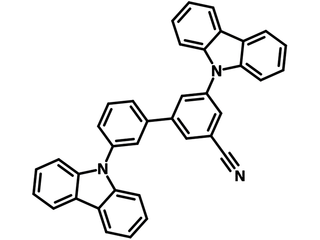mCBP-CN
CAS Number 1327163-09-6
High Purity Sublimed Materials, Host Materials, Materials, OLED Materials, Semiconducting Molecules, TADF Host Materials,mCBP-CN, electron transporting host material
Better film morphology and device thermal stability compared to mCBP, 3,3′-di(carbazol-9-yl)-5-cyano-1,1′-biphenyl, CAS No. 1327163-09-6, Sublimed ≥99.0%
mCBP-CN, or 3,3′-di(carbazol-9-yl)-5-cyano-1,1′-biphenyl, has a structure of two carbazole units attached to a biphenyl linker. The only difference that it has to the well known host mCBP is that a polar cyano (CN) group is attached to one of the phenyls. The asymmetrically attached CN group can both increase the ground-state dipole moment and greatly improve film morphology and device thermal stabilities.
The strong electron withdrawing CN group can also effectively alter the electron densities of the orbitals, making mCBP-CN an electron transporting host with deep HOMO/LUMO energy levels (while mCBP is a hole transport host material).
General Information
| Full name | 3,3′-di(carbazol-9-yl)-5-cyano-1,1′-biphenyl |
|---|---|
| CAS number | 1327163-09-6 |
| Chemical formula | C37H23N3 |
| Molecular weight | 509.60 g/mol |
| Absorption | λmax 326 nm, 335 nm in film |
| PL | λem 412 nm in film |
| HOMO/LUMO | HOMO = 6.10 eV, LUMO = 2.50 eV [1] |
| Synonyms | mCBPCN, 3′,5-di(9H-carbazol-9-yl)-[1,1′-biphenyl]-3-carbonitrile |
| Classification / Family | Carbazole derivatives, Fluorescent and phosphorescent host materials, Sublimed materials |
Product Details
| Purity | Sublimed >99.0% (HPLC) |
|---|---|
| Melting point | mp = 256 °C, Tg = 113 °C |
| Appearance | Pale White powder/crystals |
*Sublimation is a technique used to obtain ultra pure-grade chemicals. For more details about sublimation, please refer to the Sublimed Materials.
Chemical Structure
Device Structure(s)
| Device structure | ITO (50 nm)/HAT-CN (10 nm)/TAPC (40 nm)/mMCP (10 nm)/3 wt% BOBS-Z*:mCBP-CN (30 nm)/PPF (10 nm)/B3PyPB (30 nm)/Liq (1 nm)/Al (100 nm) [2] |
|---|---|
| Color |
|
| Max Current Efficiency | 15.7 cd/A |
| Max. Power Efficiency | 24.2 Im/W |
| Max. EQE | 24.2% |
| Device structure | ITO (50 nm)/HAT-CN (10 nm)/TAPC (40 nm)/mMCP (10 nm)/3 wt% BSBS-Z*:mCBP-CN (30 nm)/PPF (10 nm)/B3PyPB (30 nm)/Liq (1 nm)/Al (100 nm) [2] |
|---|---|
| Color |
|
| Max Current Efficiency | 18.7 cd/A |
| Max. Power Efficiency | 20.2 Im/W |
| Max. EQE | 24% |
| Device structure | ITO (50 nm)/HAT-CN (10 nm)/TAPC (40 nm)/mMCP (10 nm)/3 wt% ν-DABNA*:mCBP-CN (30 nm)/PPF (10 nm)/B3PyPB (30 nm)/Liq (1 nm)/Al (100 nm) [2] |
|---|---|
| Color |
|
| Max Current Efficiency | 21.4 cd/A |
| Max. Power Efficiency | 22.1 Im/W |
| Max. EQE | 22.7% |
| Device structure | ITO/BPBPA* : HATCN (40 nm : 30%)/BPBPA (10 nm)/PCZAC(10 nm)/mCBPCN:oCBP:CNIr (30 nm:50%:10%)/26DBFPTPy* (5 nm)/ZADN (20 nm)/LiF (1.5 nm)/Al (200 nm) [3] |
|---|---|
| Color |
|
| Max Current Efficiency | 42.0 cd/A |
| Max. Power Efficiency | 43.9 Im/W |
| Max. EQE | 24.1% |
| Device structure | ITO/BPBPA* : HATCN (40 nm : 30%)/BPBPA (10 nm)/PCZAC(10 nm)/mCBPCN:oCBP:CNIr (30 nm:50%:10%)/26DBTPTPy* (5 nm)/ZADN (20 nm)/LiF (1.5 nm)/Al (200 nm) [3] |
|---|---|
| Color |
|
| Max Current Efficiency | 41.0 cd/A |
| Max. Power Efficiency | 42.7 Im/W |
| Max. EQE | 23.6% |
| Device structure | ITO/BPBPA* : HATCN (40 nm : 30%)/BPBPA (10 nm)/PCZAC(10 nm)/mCBPCN:oCBP:CNIr (30 nm:50%:10%)/BmPyPB (5 nm)/ZADN (20 nm)/LiF (1.5 nm)/Al (200 nm) [3] |
|---|---|
| Color |
|
| Max Current Efficiency | 39.1 cd/A |
| Max. Power Efficiency | 40.9 Im/W |
| Max. EQE | 22.3% |
*For chemical structure information, please refer to the cited references.
Pricing
| Grade | Order Code | Quantity | Price |
|---|---|---|---|
| Sublimed (>99.0% purity) | M2345A1 | 100 mg | £260 |
| Sublimed (>99.0% purity) | M2345A1 | 250 mg | £520 |
| Sublimed (>99.0% purity) | M2345A1 | 500 mg | £850 |
| Sublimed (>99.0% purity) | M2345A1 | 1 g | £1400 |
MSDS Documentation
Literature and Reviews
- An Alternative Host Material for Long-Lifespan Blue Organic Light-Emitting Diodes Using Thermally Activated Delayed Fluorescence, S. Ihn et al., Adv. Sci., 1600502 (2017); DOI: 10.1002/advs.201600502.
- Achieving Ultimate Narrowband and Ultrapure Blue Organic Light-Emitting Diodes Based on Polycyclo-Heteraborin Multi-Resonance Delayed-Fluorescence Emitters, I Park et al., Adv. Mater., 34 (9), 2107951 (2022); DOI: 10.1002/adma.202107951.
- Novel hole blocking materials based on 2,6-disubstituted dibenzo[b,d]furan and dibenzo[b,d]thiophene segments for high-performance blue phosphorescent organic light-emitting diodes, S. Jang et al., J. Mater. Chem. C, 7, 826 (2019); DOI: 10.1039/c8tc04900a.

